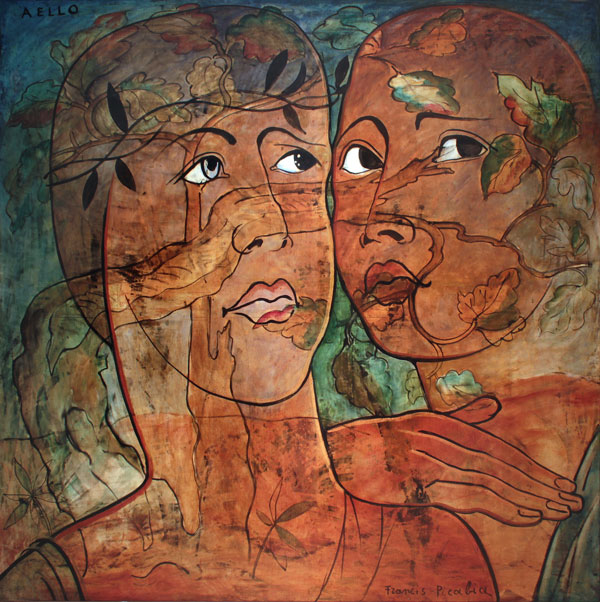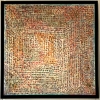THE MUSEUM OF MODERN ART EXPLORES THE PROVOCATIVE AND PROLIFIC CAREER OF FRANCIS PICABIA WITH HIS FIRST U.S. RETROSPECTIVE IN NEARLY 50 YEARS
MoMA's First-Ever Monographic Exhibition of Picabia Brings Together Some 200 Works to Advance Understanding of the Artist’s Vital Place in 20th-Century Art
Francis Picabia: Our Heads Are Round so Our Thoughts Can Change Direction
November 21, 2016–March 19, 2017
The Joan and Preston Robert Tisch Exhibition Gallery, sixth floor
NEW YORK, November 3, 2016—The Museum of Modern Art’s Francis Picabia: Our Heads Are Round so Our Thoughts Can Change Direction, on view November 21, 2016–March 19, 2017, is the first major exhibition of the artist’s work in the US in nearly half a century, and the first ever to chart the full range of Picabia’s audacious, irreverent, and profoundly influential career. “Our heads are round so our thoughts can change direction” is an aphorism coined by Picabia in 1922, and it aptly encapsulates the nonlinear, circular character of his artistic practice. This exhibition presents approximately 200 works in an array of mediums in order to advance understanding of Picabia’s unruly genius and its vital place within the history of modern art.
Francis Picabia is organized by MoMA and the Kunsthaus Zürich. The curators are Anne Umland, The Blanchette Hooker Rockefeller Curator of Painting and Sculpture at MoMA; and Cathérine Hug, Curator at the Kunsthaus Zürich; with Talia Kwartler, Curatorial Assistant, MoMA. Prior to its presentation in New York, the exhibition was on view at the Kunsthaus Zürich.
Francis Picabia. Aello. 1930. Oil on canvas,
66 9/16 × 66 9/16 (169 × 169 cm).
Private collection. © 2016 Artist Rights Society (ARS),
New York/ADAGP, Paris
| "Francis Picabia: Our Heads Are Round so Our Thoughts Can Change Direction" is a comprehensive survey of Picabia’s audacious, irreverent, and profoundly influential work across mediums. This will be the first exhibition in the United States to chart his entire career. Join MoMA director Glenn Lowry and curator Anne Umland for a discussion on the opening of the exhibition. |
|
|
|
Among the great modern artists, Francis Picabia (French, 1879–1953) remains one of the most elusive; he vigorously avoided any one singular style or medium. He is also an artist with a strong connection to New York, where he first achieved fame as a leader of the European avant- garde. Though best known as one of the luminaries of the Dada movement, his career ranged widely—and wildly—from Impressionist landscapes to abstraction, from paintings of machines to photo-based nudes, and from performance and film to poetry and publishing. Picabia’s contributions to a diverse range of artistic mediums make him especially relevant for contemporary artists, and his career as a whole challenges familiar narratives of modernism. Francis Picabia assembles key selections and bodies of work, ranging in date from the first decade of the 20th century through the early 1950s. Picabia’s widely varied work as a painter is represented, along with his activities as a publisher and contributor to vanguard journals, and his forays into screenwriting and theater. The core of the exhibition comprises some 125 paintings, along with approximately 45 key works on paper, one film, a selection of printed matter, and sound recordings of selected poems and writings. |
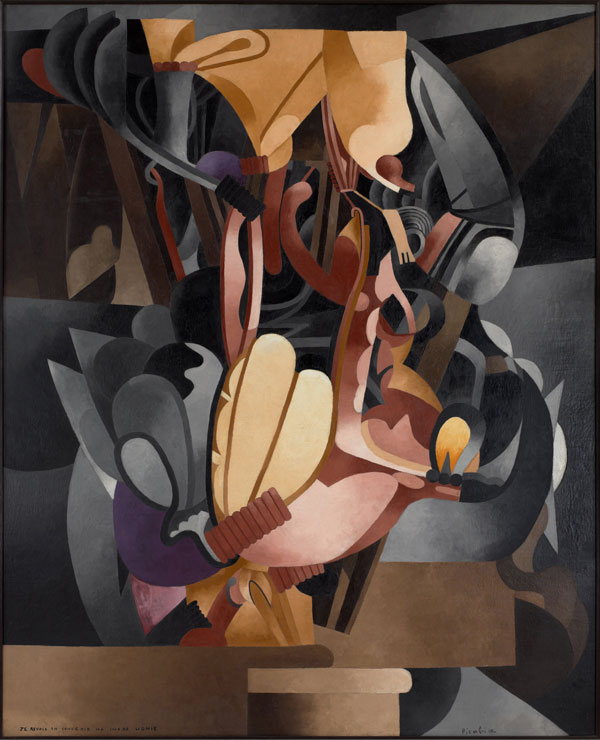 |
| Francis Picabia (French, 1879–1953). Je revois en souvenir ma chère Udnie (I See Again in Memory My Dear Udnie). 1914. Oil on canvas, 8' 2 1/2? x 6' 6 1/4? (250.2 x 198.8 cm). The Museum of Modern Art, New York. Hillman Periodicals Fund. © 2016 Artists Rights Society (ARS), New York/ADAGP, Paris. Photo: The Museum of Modern Art, John Wronn |
Beginnings, 1905–1911Picabia first made his name as an after-the-fact Impressionist painter, and the exhibition begins with works such as Effect of Sunlight on the Banks of the Loing, Moret (1905) and Untitled (Notre- Dame, Paris) (1906), which call to mind those by older artists such as Claude Monet and Alfred Sisley. But Picabia is believed to have worked from photographic postcards rather than immersing himself in nature and painting outdoors—subverting the original spirit of Impressionism and that style’s open-air techniques. This penchant for dispensing with established norms and appropriating readymade images would become a constant in his career, and these strategies would continue to elicit shock from critics and audiences alike. He quickly left Impressionism behind, cycling through a rapid succession of styles—another through-line in Picabia’s practice that is explored in thisexhibition. |
Abstractions, 1912–1914In the summer of 1912, Picabia turned to abstraction, exemplified by The Spring and Dances at the Spring [II]. Their inclusion at the Salon d’Automne that year, alongside abstract canvases by František Kupka and Fernand Léger, marked the arrival of non-objective painting in Paris. Critics reviled Picabia’s new work as “incomprehensible” although, several months later, the Armory Show opened in New York with four of Picabia’s abstractions on view, including Dances at the Spring [I], and there he was received as a “high priest” of modern art. When he returned to Paris in the summer of 1913, Picabia began work on a pair of monumental canvases that would become Udnie (Young American Girl; Dance) and Edtaonisl (Ecclesiastic), which are displayed together for the first time in the US. Critics almost universally mocked these works when they were unveiled at the 1913 Salon d’Automne in Paris, but they were subsequently heralded as early precedents for postwar abstract painting. |
![Francis Picabia. Udnie (Jeune fille américaine; danse) (Udnie [Young American Girl; Dance]). 1913. Oil on canvas, 9' 6 3/16? × 9' 10 1/8? (290 × 300 cm). Centre Pompidou, Musée national d’art moderne – Centre de création industrielle, Paris. Purchased by the State, 1948. © 2016 Artist Rights Society (ARS), New York/ADAGP, Paris. Photo: © Centre Pompidou, MNAM-CCI/Georges Meguerdtchian/Dist. RMN–Grand Palais/Art Resource, New York.](/images/stories/musees/moma/moma_picabia1913_girl_dan_h.jpg) |
| Francis Picabia. Udnie (Jeune fille américaine; danse) (Udnie [Young American Girl; Dance]). 1913. Oil on canvas, 9' 6 3/16? × 9' 10 1/8? (290 × 300 cm). Centre Pompidou, Musée national d’art moderne – Centre de création industrielle, Paris. Purchased by the State, 1948. © 2016 Artist Rights Society (ARS), New York/ADAGP, Paris. Photo: © Centre Pompidou, MNAM-CCI/Georges Meguerdtchian/Dist. RMN–Grand Palais/Art Resource, New York. |
Mechanomorphs and Dada, 1915–1922The exhibition turns to Picabia’s work during World War I, as he sought exile in New York, Barcelona, and Switzerland. He painted, drew, and became active as a writer, but the mainstay of his activity was contributing to and editing journals. His engagement with the mechanics of journal production coincided with the appearance of the machine in paintings such as Very Rare Picture on the Earth (1915). In these works, the machine was both subject and model for a newly hard-edged, precise, and impersonal approach. After the war, Picabia returned to Paris, where he joined Tristan Tzara and other Dadaists in an all-out assault on the culture of rationality that they held responsible for the war. Noteworthy works on view from this period include The Cacodylic Eye (1921), an iconoclastic group portrait of the Paris Dada movement bearing the signatures of over 50 friends and acquaintances, and St. Vitus's Dance (Rat Tobacco) (1919–20, modified 1946–49), an empty frame strung with yarn between which words were suspended. Both works relinquished artistic agency in favor of automatic procedures and renounced individual authority, functioning as both irreverent in-jokes and as attacks on the grand European tradition of painting. |
Dalmau, Littérature, and Salon Ripolins, 1922–1924On November 18, 1922, the Exposition Francis Picabia opened at the Galeries Dalmau in Barcelona, featuring almost 50 new works on paper. A section of the exhibition pays homage to Picabia’s original display, based on archival photographs. The works encompassed a dizzying array of styles: portraits of doe-eyed Spanish women hung alongside optical abstractions and geometric drawings inspired by mechanical diagrams published in a popular science magazine. Picabia continued to submit paintings to the Paris salons. Instead of traditional oils, he used commercial enamel paints (commonly referred to by the brand name Ripolin) and worked on an imposing scale intended to attract attention, creating works in both abstract and figurative modes. The bold graphic character and sinister eroticism of The Spanish Night (1922) and Animal Trainer (1923) are also seen in the contemporaneous, black-and-white covers Picabia designed for the journal Littérature. |
Ciné-Theater-Dance, 1924The composer Erik Satie approached Picabia about collaborating on a ballet in January 1924, and Picabia had the idea of also producing a film, which he imagined as “a parody of cinematic action.” Cinema and dance interacted spectacularly when the humorously titled ballet Relâche (“day off” or “no performance”) and the film Entr’acte (“intermission”) premiered on December 4, 1924. Entr’acte is screened in the exhibition alongside publicity photographs of Picabia’s sets and costumes and various related drawings by Picabia, including portraits of people involved in the ballet’s production. |
Collages and Monsters, 1924–1927In January 1925, Picabia left Paris for the south of France, near Cannes, where he pursued his longtime passions for yachting, fast cars, and casino gambling. The move also precipitated an intensely productive period of painting, as seen in his so-called Monsters: pictures of embracing couples and carnival characters, rendered in the acidic colors and saturated sheen of commercial enamel paint. These works simultaneously indulged and mocked the fashionable high society in which Picabia found himself. His use of enamel paints intensified in the mid-1920s, as did his experimentation with other unorthodox materials and processes. Collages from this period incorporate things like matches, hairpins, dry pasta, and even the literal materials of art-making: paint-can lids, brushes, and stretcher wedges. Picabia also revisited older paintings with increasing frequency. Commercial enamels proved well suited to amending, adjusting, and covering over prior works, as seen in The Lovers (After the Rain) (1925), which Picabia painted over an earlier abstraction. Over-painting became a recurrent tactic within Picabia’s practice, as would masking and superimposition. |
Transparencies, 1927–1930In 1927, Picabia began creating the “superimposed” works known as his Transparencies by alternating layers of paint with layers of resinous varnish, which allowed him to lay linear motifs atop one another while keeping them distinct. These richly layered, multi-referential compositions interweave an often dizzying array of contour images drawn from such diverse sources as Renaissance painting, Catalan frescoes, and contemporary popular culture. As seen in the exhibition, Picabia’s Transparencies range from the complex imagery of paintings like Sphinx (1929) to the masterful refinement of Aello (1930), Mélibée (1930), and Salomé (1930). |
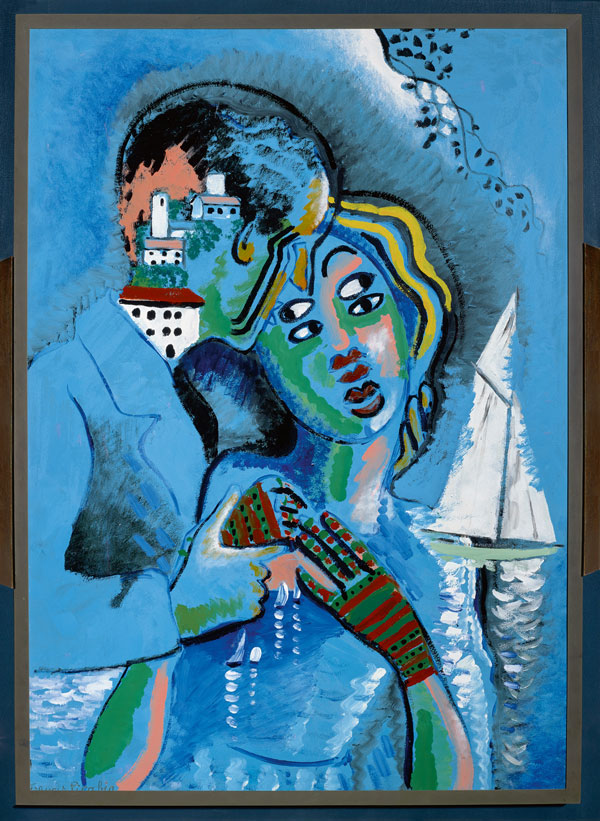 |
| Francis Picabia. Idylle (Idyll). c. 1925–27. Oil and enamel paint on wood, in a frame by Pierre Legrain, 44 5/16 × 32 1/2 × 2 15/16? (112.5 × 82.5 × 7.5 cm), with frame. Musée de Grenoble. Gitt of Jacques Doucet, 1931. © 2016 Artist Rights Society (ARS), New York/ADAGP, Paris. Photo: © Musée de Grenoble |
Eclecticism and Iconoclasm, 1934–1938The mid- and late 1930s was a period of intense material experimentation and reworking for Picabia, as he shuttled back and forth between Paris and the French Riviera. Works like Fratellini Clown (1937–38) and The Spanish Revolution (1937) exemplify the troubling malaise and sense of creeping doom that was spreading throughout Europe, as the threat of fascism and totalitarian ideologies took center stage. Despite the political unrest and looming threat of war, Picabia continued to organize lavish galas at the municipal casino for Cannes high society; he also created facial superimpositions and photo-based portraits, including one of his friend, the author and art collector Gertrude Stein. |
Photo-Based Paintings, 1940–1943Picabia remained in the south of France throughout World War II, where he painted works that combine kitsch subjects, popular culture, and politics in an unsettling mix. Many of Picabia’s wartime paintings recombine images lifted from photographs published in late-1930s soft-core pornography magazines, often preserving those photographs’ artificial studio lighting, soft focus, and optical distortions created by the camera lens. His much-debated wartime paintings remain open to interpretation, bearing witness to the moral ambiguities of this dark historical moment, and to the intricacies of an individual’s response to seismic political change. |
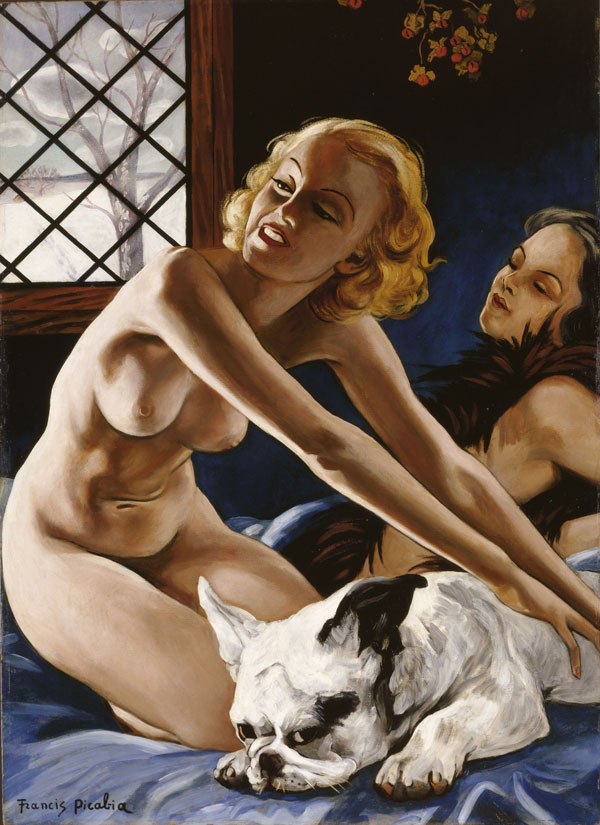 |
| Francis Picabia (French, 1879–1953). Femmes au bull-dog (Women with Bulldog). c. 1941. Oil on board, 41 3/4 x 29 15/16? (106 x 76 cm). Centre Pompidou, Musée national d’art moderne – Centre de création industrielle, Paris. Purchase from a public sale, 2003. © 2016 Artist Rights Society (ARS), New York/ADAGP, Paris. Photo: © Centre Pompidou, MNAM-CCI/Jean-Claude Planchet/Dist. RMN–Grand Palais/Art Resource, New York. |
Postwar Abstractions and Points, 1946–1952“Figurative art is dead,” Picabia said in an interview in November 1945, announcing his return to abstraction. The exhibition concludes with Picabia’s post‐WWII abstractions, including a group of encrusted, thickly repainted monochromatic “point” or “dot” paintings, some of which have titles derived from Friedrich Nietzsche. Picabia’s final paintings, The Earth Is Round (1951) and La Terre est ronde / K.O. (c. 1951) are on view, along with a number of illustrated books he produced in his last years. After suffering a stroke in June 1951, Picabia died on November 30, 1953, in the same house in Paris where he had been born. |
SPONSORSHIP:Major support for the New York presentation is provided by The International Council of The Museum of Modern Art. Generous funding is provided by Lawrence B. Benenson. This exhibition is supported by an indemnity from the Federal Council on the Arts and the Humanities. Paint provided by Farrow & Ball. Additional support is provided by the Annual Exhibition Fund. PUBLICATION:The exhibition is accompanied by a fully illustrated catalogue edited by Anne Umland and Cathérine Hug, with essays by George Baker, Carole Boulbès, Masha Chlenova, Michèle C. Cone, Briony Fer, Gordon Hughes, David Joselit, Jean-Jacques Lebel, Bernard Marcadé, Arnauld Pierre, Juri Steiner, Adrian Sudhalter, and Aurélie Verdier, as well as an illustrated chronology by Rachel Silveri and an annotated checklist by Natalie Dupêcher with Talia Kwartler. Featuring 500 illustrations and 14 essays, this publication examines the full range of Picabia’s oeuvre and a variety of topics, including the corporeal character of his abstractions, his unexpected turn to mechanical painting, his experiments with materials and source imagery, the problems of his politics, and his contemporary legacy. 368 pages, 482 illustrations. Hardcover, $75. ISBN: 978-1- 63345-003-5. Published by The Museum of Modern Art, New York, and the Kunsthaus Zürich. Available at MoMA stores and online at store.moma.org. Distributed to the trade through ARTBOOK|D.A.P. in the United States and Canada. Distributed outside the United States and Canada by Thames & Hudson. ONLINE CONTENT:At moma.org/picabia, users will have the unique opportunity to explore Picabia’s highly innovative material practices. In addition to a slide show, the website includes a digital publication, launching in mid-December, which will feature 12 richly illustrated essays contributed by an international group of conservators; each essay is focused on a different object created between 1912 and 1950 and presents pioneering new conservation research. The results of scientific analysis and technical images, including X-radiographs and reflected infrared photography, will be included, allowing viewers fresh insight into Picabia’s artistic evolution and persistently unorthodox compositions. This format makes the contributing conservators’ new research available to a broad, international audience interested in learning more about Picabia’s inventive use of materials and techniques. DIGITAL MUSIC PROGRAM:Francis Picabia, a lifelong music enthusiast, said, "The attempt of art is to make us dream, as music does." Picabia's circle of influence included the most innovative musicians and performers of the day. Terrance McKnight, a host on New York City classical music station WQXR, has paired works by Picabia with music by Erik Satie, Igor Stravinsky, Ernesto Lecuona, Edgar Varèse, Scott Joplin, and others. Visitors to the exhibition can listen to the musical selections on their smartphones. McKnight’s full playlist is available at mo.ma/picabiaplaylist. MoMA CLASSES:Francis Picabia, Modern Master Daytime session: Mondays, November 14, 21, December 5, 12, 11:00 a.m.–12:50 p.m. Evening session: Mondays, November 14, 21, December 5, 12, 6:00–7:50 p.m. This course explores Francis Picabia’s immense influence on modernism. Ever the artistic chameleon, Picabia was associated with several important avant-garde movements, including Cubism, and Dada. Working in mediums including painting, performance, poetry, and publishing, Picabia expanded the field of early-modern isms, defying attempts to neatly categorize his work. Through class discussion and gallery visits, students will gain a deeper understanding of the artist and his enduring legacy. Instructed by Heather Cotter (MA, Boston University, and MEd with a specialization in art education, Harvard University), a lecturer at The Museum of Modern Art. Nonmembers $355; MoMA members and Corporate Member employees $325; students/educators $250. Space is limited; to register for classes, visit moma.org/courses. Press Contacts: Sara Beth Walsh, (212) 708-9747 or sarabeth_walsh(at)moma.org Paul Jackson, (212) 708-9593 or paul_jackson(at)moma.org |
|
Public Information: The Museum of Modern Art, 11 West 53 Street, New York, NY 10019, (212) 708-9400, MoMA.org. Hours: Saturday through Thursday, 10:30 a.m.–5:30 p.m. Friday, 10:30 a.m.–8:00 p.m. Museum Admission: $25 adults; $18 seniors, 65 years and over with I.D.; $14 full-time students with current I.D. Free, members and children 16 and under. (Includes admittance to Museum galleries and film programs). Free admission during Uniqlo Free Friday Nights: Fridays, 4:00–8:00 p.m. MoMA.org: No service charge for tickets ordered on MoMA.org. Tickets purchased online may be printed out and presented at the Museum without waiting in line. (Includes admittance to Museum galleries and film programs). |


